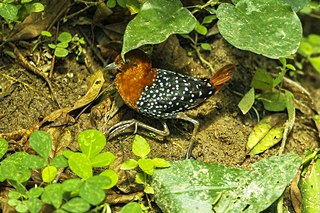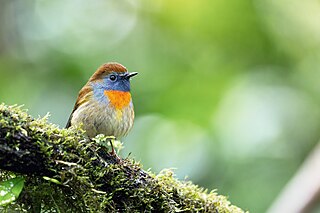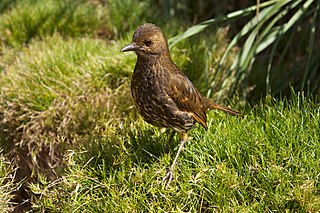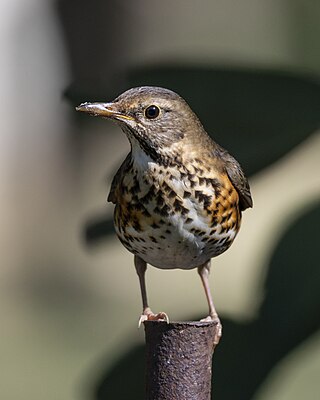
The thrushes are a passerine bird family, Turdidae, with a worldwide distribution. The family was once much larger before biologists reclassified the former subfamily Saxicolinae, which includes the chats and European robins, as Old World flycatchers. Thrushes are small to medium-sized ground living birds that feed on insects, other invertebrates, and fruit. Some unrelated species around the world have been named after thrushes due to their similarity to birds in this family.

The common blackbird is a species of true thrush. It is also called the Eurasian blackbird, or simply the blackbird where this does not lead to confusion with a similar-looking local species. It breeds in Europe, western Asia, and North Africa, and has been introduced to Australia and New Zealand. It has a number of subspecies across its large range; a few former Asian subspecies are now widely treated as separate species. Depending on latitude, the common blackbird may be resident, partially migratory, or fully migratory.

The song thrush is a thrush that breeds across the West Palearctic. It has brown upper-parts and black-spotted cream or buff underparts and has three recognised subspecies. Its distinctive song, which has repeated musical phrases, has frequently been referred to in poetry.

The mistle thrush, also spelled missel thrush, is a bird common to much of Europe, temperate Asia and North Africa. It is a year-round resident in a large part of its range, but northern and eastern populations migrate south for the winter, often in small flocks. It is a large thrush with pale grey-brown upper parts, a greyish-white chin and throat, and black spots on its pale yellow and off-white under parts. The sexes are similar in plumage, and its three subspecies show only minimal differences. The male has a loud, far-carrying song which is delivered even in wet and windy weather, earning the bird the old name of stormcock.

The blue rock thrush is a species of chat. This thrush-like Old World flycatcher was formerly placed in the family Turdidae. It breeds in southern Europe, northwest Africa, and from Central Asia to northern China and Malaysia. The blue rock thrush is the official national bird of Malta and was shown on the Lm 1 coins that were part of the country's former currency.

The white-necked thrush is a songbird found in forest and woodland in South America. The taxonomy is potentially confusing, and it sometimes includes the members of the T. assimilis group as subspecies, in which case the "combined species" is referred to as the white-throated thrush. On the contrary, it may be split into two species, the rufous-flanked thrush and the grey-flanked thrush.

The clay-colored thrush is a common Middle American bird of the thrush family (Turdidae). It is the national bird of Costa Rica, where it is well known as the yigüirro. Other common names include clay-colored robin.

Flufftails are small birds related to rails and finfoots. There are nine species, seven of which are distributed across sub-Saharan Africa, with the remaining two in Madagascar. The genus was long placed with the rail family Rallidae, but is now placed in the family Sarothruridae, along with three other species of wood rails.

The tesias are a genus, Tesia, of Old World warbler. Though once included in the large family Sylviidae, more recent research placed it within a new family, Cettiidae. The four species inhabit undergrowth of montane forest in South and Southeast Asia, where they are resident or short-range migrants. They have longish legs and appear tailless, with (seemingly) only 8 rectrices. Their simple songs are fairly loud, and their nests are typically ball-shaped. Their name is derived from Tisi, the Nepalese name for the grey-bellied tesia.

The Mongolian lark is a species of lark in the family Alaudidae found from southern Russia and Mongolia to central China.

The rufous-gorgeted flycatcher is a species of bird in the family Muscicapidae.

The Tristan thrush, also known as the starchy, is a species of bird in the thrush family that is endemic to the British overseas territories of the isolated Tristan da Cunha archipelago in the South Atlantic Ocean.

The streak-breasted scimitar babbler is a species of bird in the family Timaliidae.

The Japanese thrush is a species of bird in the thrush family Turdidae. The species is also known as the grey thrush or the Japanese grey thrush. The species was once split into two subspecies, with birds breeding in China being treated as the subspecies T. c. lateus,, but today differences are attributed to natural variation and the species is treated as being monotypic.

The great thrush is a species of bird in the family Turdidae. It is found in Bolivia, Colombia, Ecuador, Peru, and Venezuela. It is considered as the largest thrush in South America. The great thrush's size distinguishes it from the several other uniform slaty-colored thrushes in its range. It inhabits subtropical or tropical moist montane forests and high-altitude shrubland, but can also make use of degraded forest and urban areas.

The Chinese thrush is a species of bird in the family Turdidae. It is found in China and far northern Vietnam. Its natural habitats are temperate forests and subtropical or tropical moist montane forests.

Psittacopasseres is a taxon of birds consisting of the Passeriformes and Psittaciformes (parrots). Per Ericson and colleagues, in analysing genomic DNA, revealed a lineage comprising passerines, psittacines and Falconiformes. The group was proposed following an alignment of nuclear intron sequences by Shannon Hackett et al. in 2008. It was formally named as Psittacopasserae in a 2011 Nature Communications article by Alexander Suh and other authors working with Jürgen Schmitz's group, based on genetic analysis of the insertion of retroposons into the genomes of key avian lineages over the course of evolution during the Mesozoic Era.

The jungle babblers are a family, Pellorneidae, of mostly Old World passerine birds belonging to the superfamily Sylvioidea. They are quite diverse in size and coloration, and usually characterised by soft, fluffy plumage and a tail on average the length of their body, or longer. These birds are found in tropical zones, with the greatest biodiversity in Southeast Asia and the Indian subcontinent.

The Chinese blackbird is a member of the thrush family Turdidae. It was formerly considered conspecific with the related common blackbird.

The Himalayan thrush or Himalayan forest thrush is a species of bird described in 2016 and separated out from the alpine thrush Zoothera mollissima with which they were formerly lumped. The species is separated on the basis of phylogenetic studies that suggest that the population diverged from the common ancestor at least 3 million years ago. The alpine thrush breeds above the tree line whereas the Himalayan thrush breeds in forested habitats. The species breeds from Sikkim and Darjeeling in India and extends east into Tibet and further east into northwest Yunnan in China. The species differs in its song from that of the alpine thrush. The Himalayan thrush has a more musical call while that of the Alpine thrush is raspy and grating. A newly discovered Himalayan forest thrush bird was named after the birdman of India, Ornithologist Dr.Salim Ali. The name of the bird is "Zoothera salimalii". A fruit bat is also named after him "Latidens salimalii"























